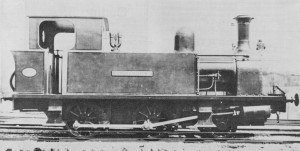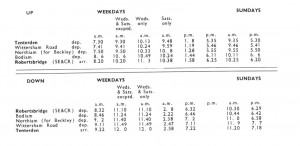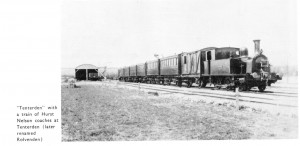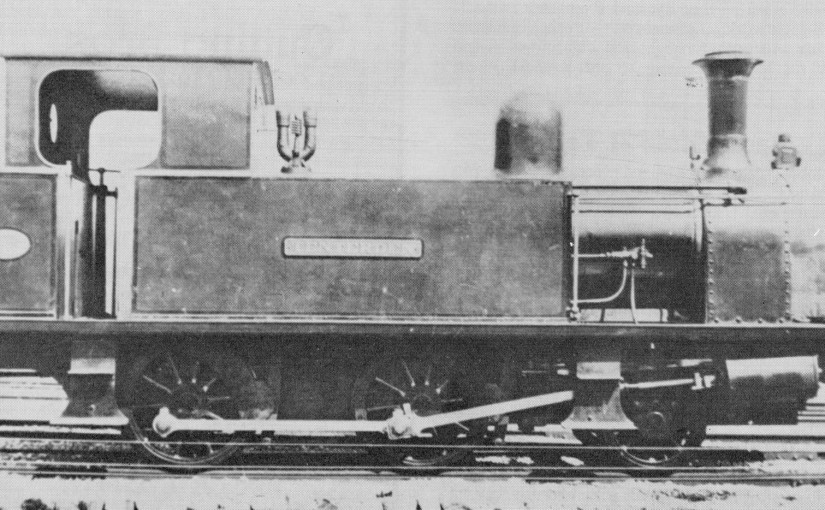“THE RAILWAY HISTORY OF RYE AND DISTRICT”
Part 1 — The Rother Valley (Light) Railway
TENTERDEN FLYER’
by E.R.Y.
The demand for a railway in the valley of the River Rother had reached crescendo pitch long before the end of the last century. The South Eastern Railway had completed its main line from London to Folkestone via Reigate and Tonbridge by the end of 1843 and the Tunbridge Wells to Hastings line during 1851. Although many lines were projected to serve the valley in the years following 1851 only the South Eastern Railway’s branch from Paddock Wood to Hawkhurst was actually constructed, before the Rother Valley (Light) Railway received statutory authorisation in 1896. That this company ever got off the ground was, perhaps, almost entirely due to the Light Railways Act, 1896, which considerably reduced construction costs.
The building of the line was carried out under supervision of the Company’s Engineer, the late Lieutenant Colonel H. F. Stephens. Economy being the watchword (as it had been with the Rye and Camber Tramway) the line was single—the standard
gauge track was made of 60 lb. to the yard rail, fastened to the sleepers by dog spikes and five fanged bolts—with a passing loop at Northiam. Built of corrugated iron and wood, the stations strongly resembled those on the Rye and Camber Tramway. If ecomomy was the watchword, optimism seems to have been a guiding principle as is evidenced by the following extract from the prospectus.
“SOURCES OF PROFIT”
The Valley of the Rother, through which the line passes, consists principally of rich grassland, and is an ideal one for a Light Railway. It is a thickly populated agricultural district, which has been greatly handicapped by the absence of facilities for the carriage of goods.
The population to be served by the railway number about 18,000, at least one hail of whom are from six to nine miles from the nearest railway station.
“Tenterden”
The transport of ordinary goods required to feed this large population would alone give this Company a considerable income.
When the line is opened for traffic a very large milk trade it is believed, will be established for the supply of Hastings, Tunbridge Wells and other large markets. Large quantities of hops and fruit are also grown in the surrounding district and would be conveyed over this railway to the markets.
Monthly sales of cattle are now held in Robertsbridge. The construction of the line will give access of this Market to the farmers and graziers in and around Northiam, Rolvenden and Tenterden, with consequent benefit to the Company. Two large flour mills, which will be specially served by the Company, will also be a source of profit.

A large excursion traffic may also be expected on the line during the summer months, from Hastings and Tunbridge Wells, and the South Coast towns to Bodiam Castle, which is a fine old Norman ruin, and a favourite object of interest to excursionists from the neighbouring towns. As many as 600 people frequently visit this Castle in one day, at present visitors are conveyed to the Castle in brakes, which drive out from St. Leonards and Hastings, the charge of the journey being 4/6d. per head. As the Company, in conjunction with the South Eastern Railway will be able to convey the visitors for nearly one half of the cost, there is no doubt that a very large proportion of this traffic will fall to this company, and in consequence of the decrease in cost a considerable increase in the number of visitors may also be confidently anticipated.”
“After years of waiting Tenterden is at last able to boast a railway station” wrote one local commentator just before the opening of the line to passenger traffic on 2nd April, 1900, “which should stand for so much in the way of progress. The line to Robertsbridge is not, perhaps, all that the people of the district hoped for, but at any rate it will enable them to get in touch with the outer world in a way not previously possible.
There are five stations on the line viz. Tenterden, Wittersham Road, Northiam, Bodiam and Robertsbridge Junction. On the opening day for passengers there will be a big crowd travelling, a very large number of the inhabitants of Tenterden, having for a long time past, made up their mind if possible, to be passengers on the first train that leaves Tenterden station.”

The fares from Tenterden station, which was well over a mile from the town at the foot of a steep hill, were as follows
To Robertshridge: Third Class—1/1d. First Class—1/10d. (Return 2/-d.)
To Bodiam: Third Class—9d. First C1ass.—1/6d.
To Northiam: Third Class—6d, First Class—1/3d.
To Wittersham: Third Class—3d. First Class—9d.
The third class single fare from Tenterden to Wittersham Road was 3d., from Wittersham Road to Northiam 3d., from Northiam to Bodiam 4d. and from Bodiam to Robertsbridge 4d. Although the fares were reasonable, the passenger service appears to have been far from adequate as is evidenced by the first timetable.
To work the line the Company initially bought two 2-4-0 outside cylinder tank engines from R. W. Hawthorne Leslie of Newcastle. The dimensions of the locomotive named “Tenterden” were as follows cylinders, 12” x 18”; leading wheels, 2’9” diameter; driving wheels, 3 ‘3” diameter; working pressure, 1401b. per sq. in.; boiler, 8’6” long, 3’s” diameter; tank capacity, 600 galls., heating surface tubes, 448 sq. ft.; firebox, 39 sq. ft. and grate area 9 sq. ft.; weight in working order, 24 tons, 2 cwt. The dimensions of the other engine “Northiam” were almost identical. Both were painted dark blue, lined out with white, black and vermilion. After long careers they were sold for scrap in 1941. “Northiam” featured, with slight modifications, as “Gladstone” in the famous Will Hay film “Oh Mr. Porter.” As regards passenger stock, six four wheeled coaches were purchased from Hurst Nelson and Company. Constructed of polished teak, they were of the saloon type with doors at each end.
A contemporary newspaper gives the following account of the opening of the line on Monday, 2nd April, 1900.
“Monday last will long be a memorable day in Tenterden, for the Public were then for the first time able to travel from the Town by rail. During the last 50 years project after project has been mooted, and surveys have been made in every direction, but until the Rother Valley Railway Company came on the scene every hope had been dashed to the ground. This Company started operations in October, 1898, and even when the line had been fenced in, few imagined that it would ever be really completed.

A bitter north wind blowing and a severe frost did not make a pleasant morning on Monday to tempt the public from their home at the early hour of 7.30 a.m., at which the first train was timed to start, but nevertheless when this memorable train steamed out of the station, well filled with passengers, the platform was crowded with a delightful crowd, amongst those who either travelled by the first two trains or were present at the platform were :-
The Vicar (Rev. S. C. Lepard), Mr. E. K. Hardcastle, J.P., Mr. and Mrs. J. M. Mace, Mr. R. B. Curteis, Mr. H. B. Mace, Mr. W. A. M. Milne, Miss H. Peel, Miss Milne, Mr. E. W. Tordifle and Miss Tordiffe, Mr. G. Edmonds, Mr. J. W. Eden and Miss Eden, Mr. A. R. Boorman, Miss K. Boorman, Miss Finn, Miss Hukins, M. G. F. Varty, Mr. A. Ridley, Mr. W. B. Hook, Mr. and Mrs. Jabex Chacksfield, Mr. A. W. Hook, Mr. W. Hilder, Mr. E. Hilder, Mr. W. C. L. Turner, Mr. and Mrs. W. Thomson, Miss Thomson, Mr. H. Willsher, Mr. W. Thomson, Jun., Mrs. J. Howard, Mr. H. Hissack, Mr. E. Stanger, Miss N. Stranger, Miss K. Hook, Mr. C. Milsted, Mr. W. Bennett, Mr. C. Skinner, Mr. S. Body, Mr. A. Pinyon, Mr. W. Macdonald, Mr. and Mrs. I. Sayers, Miss G. Wood, Miss J. Wood, Mr. F. E. Pilcher and Mr. H. Harris.
There were six carriages on the first two trains, two First and four Third Class . . . The journey is an extremely pretty one and must during the summer months attract a large number of visitors. Leaving Tenterden on the right of the hill, a good view is obtained of Rolvenden Church, and throughout the line capital views are displayed of a number of very fine old churches, amongst which are Wittersham, Newenden, Sandhurst, Bodiam, Salehurst and Robertsbridge. The first station we arrive at is Wittersham, which is about l~ miles from Rolvenden and about the same distance from Wittersham Station. Both the Tenterden and Wittersham stations are actually in Rolvenden Parish, and some of the inhabitants of the latter Parish consider they have a grievance having two stations in the Parish with other names. Next Northiam, it is about ~ mile from Newenden and about 3~ from Beckley, the scenery here is charming and such a spot as picnicers love to find. We come next to Bodiam, which is quite close to the lovely Bodiam Castle to which hundreds and perhaps thousands of visitors flock every summer. Next stopping place is Robertsbridge, where the trains run in side by side with the S.E.R. trains. One has only to walk a few yards and enter a train for Hastings or cross over the bridge for trains for Tunbridge Wells or London.
During the afternoon on Monday, by the 2.58 from Robertsbridge, Sir Myles Fenton, the Chairman of the Directors of the Rother Valley Railway Company, visited the line through to Tenterden accompanied by the engineer of the line, Col. H. F. Stephens of Tonbridge. The trains throughout the day were largely patronized, with large crowds also to send them off.”
Three years later the railway was extended to Tenterden Town, the original Tenterden station being renamed Rolvenden. Tenterden—the ‘limb’ of Rye in the Cinque Ports Confederation—had at last been put on the railway map.
From Rye’s Own November 1967
All articles, photographs and drawings on this web site are World
Copyright Protected. No reproduction for publication without prior
arrangement.
